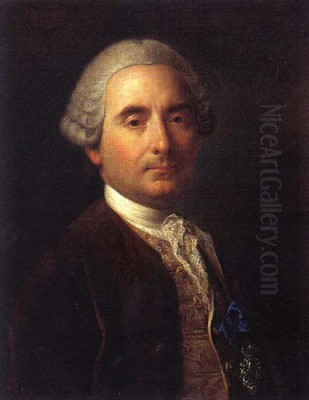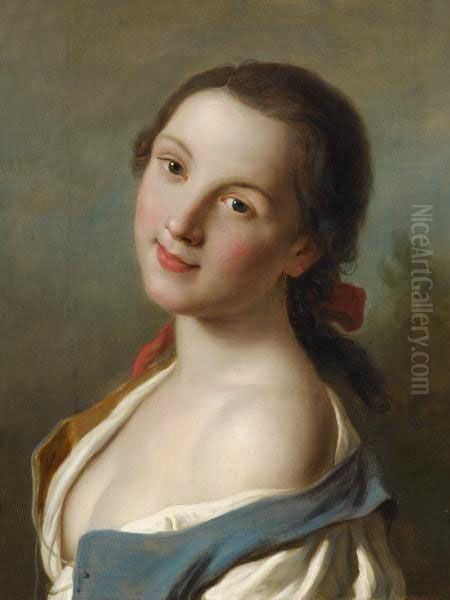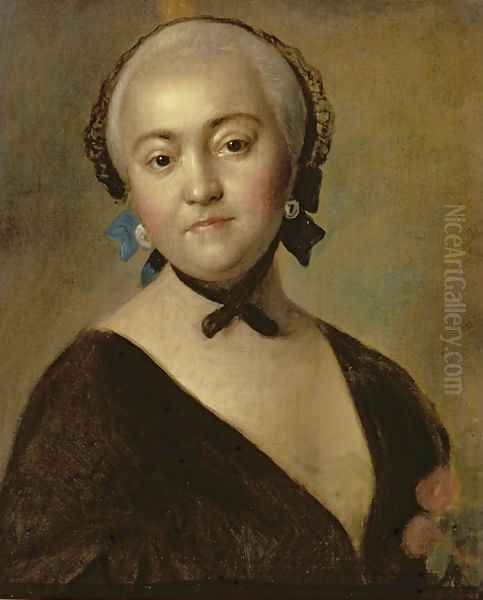An Introduction to the Artist and His Time

The 18th century in Europe was a period of profound cultural shifts, transitioning from the grandeur of the High Baroque to the lighter, more intimate sensibilities of the Rococo, and eventually paving the way for Neoclassicism. Within this dynamic artistic landscape, portraiture flourished, catering to the demands of royalty, aristocracy, and a growing affluent class eager to see themselves immortalized. It was in this era that Pietro Antonio Rotari (1707-1762), an Italian painter born in Verona, carved a unique and enduring niche for himself. While skilled in various genres, Rotari became particularly celebrated for his portraits, especially those of women, capturing not just their likeness but also a delicate spectrum of emotions and inner life with remarkable sensitivity and technical finesse. His career would take him from the artistic centers of Italy to the imperial courts of Vienna, Dresden, and ultimately, St. Petersburg, where he left an indelible mark.
Early Life and Artistic Formation in Verona
Pietro Antonio Rotari was born on September 30, 1707, in Verona, a city with a rich artistic heritage in the Veneto region of Italy. His background was respectable; his father was noted as a doctor and scientist, suggesting an environment where intellectual and perhaps cultural pursuits were valued. This likely provided the young Rotari with opportunities beyond those available to many aspiring artists of the time. His initial artistic inclinations led him to study etching, a technique requiring precision and a keen eye for line, under the guidance of the Flemish engraver Robert van Audenaerde, who was active in the region.

His formal training in painting began in earnest between 1723 and 1725. During this period, he became a pupil of Antonio Balestra, a prominent Veronese painter whose style blended Venetian colorism with the more academic traditions of Rome, influenced by Carlo Maratti. Balestra was a significant figure in Verona, known for his altarpieces and historical subjects. Studying under him provided Rotari with a solid grounding in the fundamentals of drawing, composition, and the prevailing late Baroque aesthetic, equipping him with the technical skills necessary for a successful career. This early training in Verona laid the foundation upon which his distinctive style would later be built.
Journeys Through Italy: Honing a Craft
Like many ambitious artists of his time, Rotari understood the necessity of experiencing the major artistic centers of Italy to broaden his horizons and refine his skills. Around 1725, he journeyed to Venice, the vibrant heart of painting in Northern Italy. There, he would have absorbed the rich colors, dynamic compositions, and painterly techniques characteristic of the Venetian school, then dominated by figures like Giovanni Battista Tiepolo. The Venetian emphasis on light and color undoubtedly left an impression on his developing palette.
His quest for knowledge then led him south to Rome, the epicenter of classical tradition and Baroque grandeur. Between 1727 and 1731, he studied under the guidance of Francesco Trevisani, a respected painter known for his elegant and refined style, which successfully merged late Baroque tendencies with an emerging Rococo sensibility. Exposure to the works of Roman masters, both past and present, further enriched Rotari's artistic vocabulary. He also spent time in Naples, where he likely encountered the powerful dramatic style of Francesco Solimena, a leading figure of the Neapolitan Baroque, known for his dynamic compositions and use of chiaroscuro.
By 1734, Rotari felt prepared to establish himself independently. He returned not to Verona, but to Florence, another city steeped in artistic history. There, he took the significant step of opening his own private painting academy. This move indicates not only his confidence in his abilities but also his ambition to pass on his knowledge and potentially cultivate his own following. During this period, he began receiving commissions for various works, including paintings for churches and palaces in cities across Northern and Central Italy, such as Bergamo, Brescia, Caserta, and Como, demonstrating his growing reputation within his home country.
The Essence of Rotari's Style: Capturing Character and Emotion

Pietro Antonio Rotari's mature style is a captivating blend of influences, refined into a distinct artistic personality. While rooted in the Italian Baroque, his work often displays the lighter touch, delicate palette, and intimate focus associated with the Rococo style that gained prominence across Europe during his lifetime. His primary renown rests on his portraiture, particularly his depictions of women and young girls. He possessed an exceptional ability to render likeness with realism while simultaneously imbuing his subjects with an air of grace, elegance, and often, a subtle psychological depth.
A hallmark of Rotari's portraiture is his focus on capturing fleeting expressions and moods, often referred to as "teste di carattere" or character heads. These works go beyond simple likeness to explore nuances of emotion – innocence, contemplation, mischief, melancholy, or quiet joy. This approach shows an affinity with the Dutch 17th-century tradition of "tronies" (character studies, often in exotic costume) and the French academic practice of "têtes d'expression," but Rotari infused these formats with an 18th-century sensibility, emphasizing charm and sensitivity over purely academic or dramatic display.
Technically, Rotari was highly accomplished. His brushwork is typically refined and smooth, allowing for meticulous attention to detail in fabrics, lace, and jewelry, enhancing the sense of realism and luxury. He employed a sophisticated understanding of color, often using soft, harmonious palettes, particularly in his pastels, a medium in which he excelled alongside oil painting. His skill in pastel rivaled that of specialists like the celebrated Venetian artist Rosalba Carriera. Furthermore, Rotari adeptly used chiaroscuro (the contrast of light and shadow) not just for modeling form, but also to create atmosphere and focus attention on the sitter's face and expression, adding a layer of intimacy and psychological presence to his works. He also produced "tête de fantaisie" or fantasy heads, which allowed for greater imaginative freedom.
Ascent to European Courts: Vienna and Dresden
By the mid-18th century, Rotari's reputation had grown sufficiently to attract attention beyond Italy. His skill in portraiture, particularly his flattering and sensitive depictions, made him desirable to the royal and aristocratic patrons who dominated European high society. In 1749, his standing was formally recognized when the Republic of Venice bestowed upon him the title of "Conte dal Senato Veneto" (Count of the Venetian Senate), a significant honor reflecting his artistic achievements.
Around 1750, Rotari traveled to Vienna, the capital of the Habsburg Empire. There, he found favor at the imperial court and reportedly received commissions from Empress Maria Theresa herself, painting portraits that likely adhered to the formal yet increasingly refined tastes of the Viennese aristocracy. His time in Vienna may have also exposed him more directly to the work of other international artists, potentially including the Swiss pastel portraitist Jean-Étienne Liotard, whose realistic and often unidealized portraits were also popular in European courts during this period.
Following his success in Vienna, Rotari's talents were sought in Dresden, the capital of Saxony, which under Augustus III, King of Poland and Elector of Saxony, had become a major center for arts and culture, often dubbed "Florence on the Elbe." Between 1752 and 1753, Rotari worked for Augustus III, a renowned collector and patron. One of his notable works from this period is the Portrait of King Augustus III of Poland. His time in Dresden further solidified his reputation as a portraitist capable of satisfying the demands of the highest levels of European society, paving the way for the final, most prestigious phase of his career.
The Russian Zenith: Court Painter in St. Petersburg
The pinnacle of Pietro Antonio Rotari's career arrived in 1756 when he received an invitation from Empress Elizabeth Petrovna to come to St. Petersburg, the burgeoning capital of the Russian Empire. Russia, under rulers like Peter the Great and Elizabeth, was actively seeking Western European artistic talent to modernize its culture and adorn its imperial court. Rotari accepted the invitation and was appointed as the official Court Painter, a position of immense prestige and opportunity.
Rotari remained in St. Petersburg for the rest of his life, enjoying considerable favor under Empress Elizabeth and, briefly, under her successor Peter III, and then Catherine the Great who acquired many of his works after his death. His tenure at the Russian court was remarkably prolific. He painted numerous portraits of the imperial family and members of the Russian aristocracy. However, he is perhaps most famous for the vast series of paintings commissioned by the Empress, depicting young women and girls, often dressed in various national costumes or representing different emotional states.
These works, often variations on the "teste di carattere" theme, became immensely popular. Hundreds of these small, intimate portraits were produced, likely with the assistance of a studio, to decorate the imperial palaces. A large collection of these, numbering over 360, was famously used to adorn the walls of one room in the Peterhof Palace, which became known as the "Cabinet of Fashions and Graces." These paintings, such as those generically titled Portrait of a Young Woman, showcased Rotari's signature style – delicate rendering, subtle emotional expression, and an appealing blend of realism and idealization. His work significantly influenced the development of portrait painting in Russia, setting a standard for elegance and technical skill that would inspire subsequent generations of Russian artists like Fyodor Rokotov and Dmitry Levitzky.
Navigating the World of Patronage: Social Acumen
Beyond his artistic talent, Pietro Antonio Rotari appears to have possessed considerable social grace and diplomatic skill, qualities essential for navigating the complex world of 18th-century court patronage. Sources suggest he was charming and adept at interacting with the nobility and royalty who commissioned his work. His ability to secure prestigious appointments in Vienna, Dresden, and ultimately St. Petersburg speaks not only to his artistic merit but also to his capacity to cultivate relationships and make a favorable impression in elite circles.
There are accounts suggesting that Rotari occasionally used his art strategically, gifting paintings to influential individuals to curry favor or advance his position. This practice was not uncommon among artists of the period, who often relied heavily on the goodwill and continued support of powerful patrons. Such actions reflect a pragmatic understanding of the social dynamics inherent in court life and the art market of the time. His success in maintaining a high-profile career across multiple European courts for over a decade indicates a keen awareness of how to balance artistic integrity with the expectations and demands of his patrons, ensuring his continued desirability and employment. His generosity, whether strategic or genuine, contributed to his positive reception.
Rotari in the Tapestry of 18th-Century Art: Contemporaries and Context
To fully appreciate Pietro Antonio Rotari's place in art history, it is helpful to consider him alongside his contemporaries and within the broader artistic currents of his time. His training connected him directly to established masters: the engraver Robert van Audenaerde provided early technical grounding, while Antonio Balestra in Verona offered a solid foundation in late Baroque painting. His studies in Rome with Francesco Trevisani exposed him to a more elegant, refined style, and his time in Naples likely brought him into contact with the dramatic intensity of Francesco Solimena.
In the wider European context, Rotari operated during a period rich with talent. In Venice, the towering figure was Giovanni Battista Tiepolo, master of large-scale decorative frescoes, though Rotari's focus on intimate portraiture set him apart. His skill in pastels placed him in the company of specialists like Rosalba Carriera, whose delicate portraits had earned her international fame earlier in the century, and Jean-Étienne Liotard, whose travels and distinctive style made him a unique figure in court portraiture.
As a court painter traveling internationally, Rotari was part of a select group sought after by European monarchs. His contemporaries in this sphere included figures like Anton Raphael Mengs, a German painter who became a leading proponent of Neoclassicism and worked extensively in Dresden and Madrid, and Pompeo Batoni in Rome, renowned for his portraits of Grand Tourists. While Rotari's style remained closer to the late Baroque and Rococo, his success highlights the demand for skilled portraitists across Europe. His work also stands in the long tradition of Venetian art, recalling the emphasis on color and sensuousness found in earlier masters like Titian, Tintoretto, and Veronese, albeit adapted to the tastes and scale of the 18th century.
Enduring Legacy and Historical Perspective
Pietro Antonio Rotari died in St. Petersburg on August 31, 1762, at the relatively young age of 55. Despite a career that spanned less than four decades, he left behind a significant body of work and a notable legacy, particularly in the realm of portraiture. His most profound impact was arguably on the development of art in Russia. As a favored court painter during a formative period for Western-style art in the Russian Empire, his elegant and sensitive style provided a model for Russian artists and helped shape the tastes of the aristocracy. Artists like Fyodor Rokotov and Dmitry Levitzky, who rose to prominence in the later 18th century, built upon the foundations laid by foreign masters like Rotari, developing a distinctively Russian school of portraiture.
Historically, Rotari is valued for his technical skill, his refined aesthetic, and especially his sensitive portrayal of women and children. His "character heads" represent a fascinating exploration of emotion and typology within the constraints of portraiture, offering intimate glimpses that contrast with the more formal state portraits of the era. While perhaps not as revolutionary as some of his contemporaries who pioneered Neoclassicism, Rotari excelled within the late Baroque and Rococo idioms, creating works of enduring charm and beauty. His paintings are held in major museums across Europe, including the Hermitage Museum in St. Petersburg (which houses many works from the imperial collections, including Peterhof), the Uffizi Gallery in Florence, and the Gemäldegalerie Alte Meister in Dresden.
His work continues to be appreciated for its elegance, psychological nuance, and masterful technique. He remains a significant figure for understanding the cross-cultural artistic exchanges of the 18th century and the specific evolution of portrait painting in Italy, Central Europe, and Russia.
Conclusion: A Master of Intimate Portraiture
Pietro Antonio Rotari stands as a testament to the artistry and adaptability required for success in the competitive European art world of the 18th century. From his beginnings in Verona, through his formative travels in Italy, to his celebrated tenure at the imperial courts of Vienna, Dresden, and St. Petersburg, he consistently demonstrated exceptional skill, particularly in the art of portraiture. His unique ability to capture the delicate beauty and subtle emotions of his subjects, especially women, earned him widespread acclaim and a lasting place in art history. His numerous "teste di carattere" remain captivating studies of human expression, blending realism with Rococo grace. As a key figure at the Russian court, he played a vital role in transmitting Western European artistic styles and standards, leaving a tangible legacy in the palaces and museums of St. Petersburg. Pietro Antonio Rotari's paintings continue to enchant viewers with their technical brilliance, sensitivity, and timeless elegance.